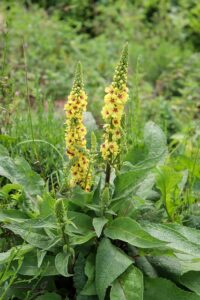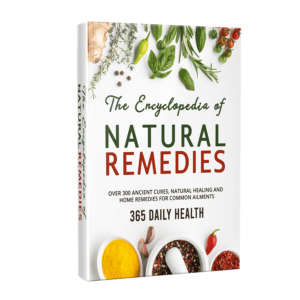The medicinal properties of mullein or Verbascum thapsus have been known and appreciated for centuries. Traditionally, this herb was used to treat a variety of ailments including respiratory problems such as bronchitis, asthma and coughs. It has also been used topically to help heal wounds and skin irritations and for digestive complaints.

Identifying Mullein
Identifying mullein is relatively easy, due to its distinctive tall, yellow-flowered spires. As a medicinal herb, mullein has been prized for its anti-inflammatory and antispasmodic effects. It can help reduce muscle tension and soothe sore throats and coughs. When taken internally in the form of tea or tincture, it may provide relief from respiratory ailments
Geographical distribution of mullein
The geographical distribution of mullein is wide-ranging and includes temperate regions in Europe, North America, Asia, and Parts of Africa. The plant has been traditionally used in folk medicine for centuries with its purported properties ranging from remedy for sore throats to treatment for headaches.
Medicinal Properties of Mullein
The medicinal properties of mullein have been recognized in many cultures. In India, for example, it is used to treat colds and congestion; while in Greece it is prescribed as a remedy for kidney problems. It has also been traditionally used as an aid to digestion, helping to reduce gas and bloating.
https://onlinelibrary.wiley.com/doi/10.1002/ptr.1653
Active Chemical Compounds in Mullein
The Active Chemical Compounds of mullein are coumarin, which is believed to provide some of the medicinal benefits. Coumarin has been found to have antiseptic properties, and it may be beneficial in helping fight off infections and inflammation. Other compounds present in mullein include saponins, flavonoids, tannins, iridoid, phenylethanoid and phenylpropanoid glycosides, hesperidin as well as vitamin C and minerals.
Sapoins, flavonoids and tannins are known for their antimicrobial properties. They may also help in fighting off viruses and bacteria. This makes mullein an effective herbal remedy for many ailments, including ear infections, sinusitis, bronchitis, and other respiratory conditions.
Iridoid glycosides found in mullein also have anti-inflammatory properties that can help reduce inflammation and improve overall health. The phenylethanoid and phenylpropanoid glycosides present in mullein are known to provide relief from coughs, sore throats, bronchitis, and asthma symptoms. Hesperidin is one of the active compounds that may be beneficial for reducing inflammation and promoting better digestion.
In addition to the medicinal properties of mullein, its flowers are also edible and can be used in recipes as a healthy source of antioxidants. The leaves can also be consumed either fresh or dried and have a mild flavor that makes them ideal for teas, tinctures, and other herbal remedies.
https://pubmed.ncbi.nlm.nih.gov/35088467/
These active chemical compounds all work together to make mullein a powerful medicinal herb, with numerous potential benefits.
Mullein as a Natural Remedy
Traditional and Modern medicinal uses of mullein can be found in many cultures around the world. It is most commonly used as an herbal tea to help treat respiratory ailments, including coughs and colds. In some cultures, it is also taken internally as a tincture or decoction for relief from headaches, stomachaches, and other digestive issues. Topically, mullein has been used to treat skin irritations, such as eczema and psoriasis. Additionally, it has been used to help reduce muscle tension, ease inflammation, and soothe sore throats.
Specific Historical and Modern Uses of Mullein
Mullein for respiratory conditions: It is most commonly used as an herbal tea to help treat respiratory ailments, including coughs and colds. Mullein can be steeped in hot water for 10-15 minutes to create a soothing infusion that can help reduce inflammation of the nose and throat area.
Mullein-infused oil for earaches: Some studies indicate Mullein may be useful for earaches.
Mullein for headaches: In some cultures, mullein is also taken internally as a tincture or decoction for relief from headaches
Mullein for digestive issues. mullein has also been traditionally used as an aid to digestion, helping to reduce gas and bloating. It can be made into a tea or taken in capsule form for best results.
Mullein for UTI: One study indicated mullein extract was effective against many of the microorganisms causing UTI.
Mullein for skin Irritations: Topically, mullein has been used to treat skin irritations, such as eczema and psoriasis. A poultice can be made from the leaves and applied to the affected area for quick relief.
Mullein for muscle tension: Mullein’s anti-inflammatory properties make it ideal for reducing muscle spasms and easing pain. A warm compress of mullein tea can help relax tense muscles, while a massage oil infused with mullein oil may also provide relief.
https://pubmed.ncbi.nlm.nih.gov/31456524/
https://botanicalinstitute.org/mullein/
It should be noted many of these studies were test tube studies and human trials are needed to confirm.
How to Use Mullein
To make a tincture from mullein, simply steep the dried herb in vodka or other high-proof alcohol for several weeks, strain it, and store in a glass jar. For a tea infusion, add 1 teaspoon of dried mullein leaves to one cup of boiling water, let sit 10 minutes, then strain before drinking. For a massage oil or poultice made with mullein oil, just mix 2 teaspoons of mullein oil with 1 tablespoon of carrier oil and apply to the affected area. With its many uses, it’s no wonder that mullein has been used for centuries as a natural remedy.
Mullein is also known to help soothe skin inflammations, such as rashes, bug bites, and other irritations. To make a poultice, mix equal parts of powdered mullein and warm water until it forms a paste-like consistency. Apply the poultice to the area and cover with a clean cloth. Let sit for 15 minutes before removing and rinsing off with cool water. This method can help reduce redness, itching, and swelling in the affected areas.
How to Dry Mullein Leaves
Dried mullein leaves can be used for many of the same medicinal purposes as fresh, and can easily be made at home. To dry mullein leaves, start by cutting off the stems and discarding any yellowed or damaged leaves. Spread the freshly-cut leaves out on a baking sheet in an even layer and bake in a preheated oven set to 200°F for 1-2 hours, or until the leaves are completely dry. Once done, let cool and store in an airtight container to maintain moisture and freshness.
Mullein can also be dried using other methods such as air drying or microwave drying. To air dry leaves, simply hang them upside down in a well-ventilated area for 1-2 weeks. To microwave dry leaves, spread the freshly-cut leaves in a single layer on a paper towel and place in the microwave for 1 minute intervals until completely dry.
Mullein is an incredibly versatile herb with many medicinal uses, from soothing respiratory issues to easing skin conditions. Whether you use fresh or dried mullein leaves, just remember to always consult your healthcare provider before using any natural remedy. With a bit of care and knowledge, you can make the most out of this incredible herb!
Recommended Dosage
When it comes to the recommended dosage of mullein, it greatly depends on the form in which you’re using it. For a mullein tea made from dried leaves, a common recommendation is to steep one to two teaspoons of dried mullein leaves or flowers in one cup of boiling water for 10 minutes. If you’re using a mullein extract, adhere strictly to the manufacturer’s instructions, which usually suggest a dosage of 1-4 ml three times a day. As with any herbal remedy, it’s critical to consult with your healthcare provider before beginning any new treatment to ensure it’s safe for your specific health condition and will not interfere with any medications you’re currently taking.
Mullein is also widely available as capsules, tinctures, salves and ointments. For the most part, these products contain active compounds extracted from mullein leaves and flowers that may be more concentrated than natural forms of the herb. If you’re interested in using a certain form of mullein for medicinal purposes, it’s important to read the labels carefully to make sure it contains the active ingredients you need. Again, you should always consult with your healthcare provider before taking any new supplement or applying any topical product to your skin.
Precautions and Side Effects
Mullein is generally considered safe and well-tolerated by most people. It has been used for centuries in folk medicine without significant side effects. However, some people may experience mild digestive symptoms such as nausea or vomiting when taking mullein orally. Additionally, individuals with asthma or allergies should exercise caution when using mullein due to its potential to cause allergic reactions.
Conclusion
Mullein has an interesting history as a medicinal herb and has had studies done that seem to support some of the conditions it has been used to treat. However, as always this information is just meant to be entertaining and informational not as a substitute for your medical provider’s advice. Be sure to seek out that advice before trying any herbal supplement.
Note: This content is for informational purposes only and should not be considered medical advice. As always, consult with your healthcare provider before making any changes to your diet or medications including herbs.
For more on the medicinal properties of herbs click here.
If you are interested in passionflower medicinal properties click here.

